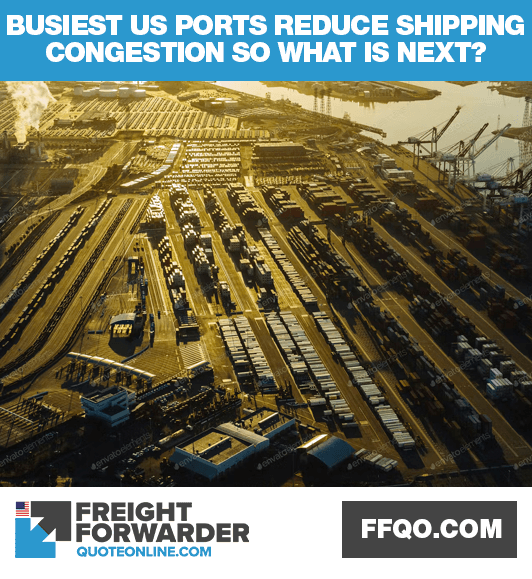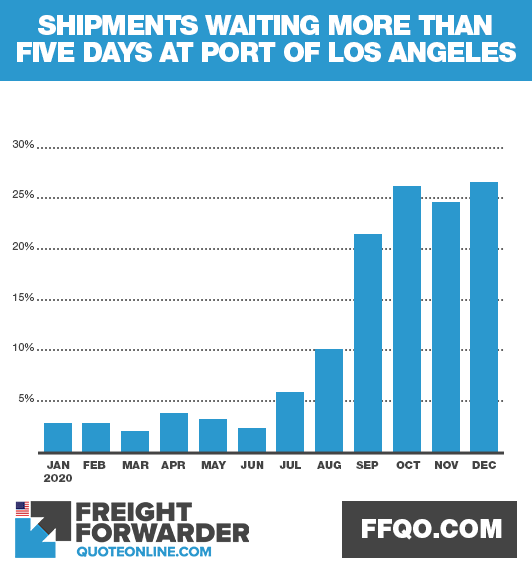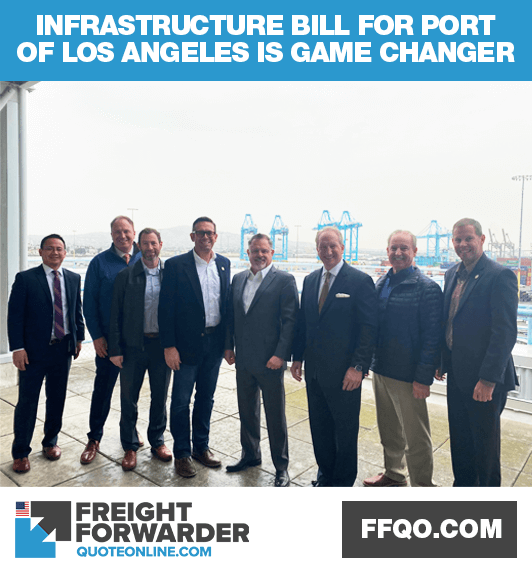Worker shortages and slowdowns at freight hubs from the pandemic combined with returning consumer demand has created a supply chain crisis with its epicenter at the busiest ports in America. The busiest shipping complex in the US in 2021 has been a year like no other.
Conditions have been unprecedented for America’s most hectic sea freight ports. Record shipping congestion and container-crowded wharfage at the Long Beach and Los Angeles seaports have been the epicenter of America’s logistics network predicament. It is solely through total commitment to and help from numerous quarters that the pandemic-caused freight gridlock is at long last starting to show signs of easing. Now the next steps need to be decided on, to fully resolve this shipping disaster and ensure it doesn’t happen again.

Busiest ports in America get on top of pandemic-induced shipping congestion – what happens next?
Our busiest ports have been working around the clock
A pandemic-induced buying boom and supply chain crisis led to an unprecedented backlog of ships lingering offshore and towering stacks of colorful containers clogging the entirety of the dockyard. In the early days of the pandemic, the ports were almost at a standstill and imports slowed dramatically creating supply chain issues around the world.
Return consumer demand rate tenfold of supply chain capacity growth
The explosion in consumerism coupled with the logistics network disaster caused an unparalleled backing-up of container ships waiting at sea to dock, and the ports being choked with huge mountains of bright-colored containers. When the pandemic was in its infancy the seaports ground to a halt and the movement of inward goods was drastically retarded. This caused logistical network problems worldwide.
China has been supplying the US with between 20 and 25 percent more containers than previously. Growth of the logistics network is planned at between 2 and 4 percent. Increasing that capacity by 25 percent quickly is not practicable. Of all container goods inwards in America, 40 percent go through the Long Beach and Los Angeles seaports. The big growth in market pressure coupled with the constant buildup of vessels standing at sea outside the wharfs has maintained the enormous push to resolve the freight congestion.
Record breaking cargo throughput to stabilizes shipment wait times
LA became, in June 2021, the first seaport in the western hemisphere to handle 10M containers in a year. Such a huge amount of cargo has never before passed through the facility. This volume of cargo moving through, however, has been matched by unprecedented holdup and obstruction. For months on end the port has experienced record numbers of vessels sitting offshore, idle, for some time, This has created another problem, because these ships, sitting idle offshore, are pouring toxic waste into the water, thereby causing problems for both shoppers and merchants.
For months the seaports have sought solutions to the problem, partnering with the Biden government to find options, working longer hours, driving faster clearing of vacant containers and obtaining more room for storage. This team approach is working; the crush of ships standing by and the logjam overall are resolved at last.
Longshoremen are pushing more freight through the facility than ever before in more than 100 years of operation. Gene Seroka, Executive Director of LA Port, speaking at a meeting of the LA Board of Harbour Commissioners, said that ports are working at more than 100% over capacity in order to deal with the pressure.
Seroka said there is no button that can be pressed to free everything up as fast as possible. He stated that it needs everyone working together cohesively to achieve that.
At present there is no place to move portside; every inch is in use. Within the shipyard, thousands of longshoremen are working 24×7 to unload the containers individually, dispatching the contents to waiting rail and road transport, which is even parked in the surrounding streets. The freight is then transported to shops and storage facilities, ultimately, reaching the homes of impatient shoppers.

Graph of shipments waiting more than five days at Port of Los Angeles
Next step is addressing the truck shortage to transport unloaded cargo
The Long Beach, Los Angeles and Biden administration are working together to regulate and resolve the logjam To do this they have been working 24×7, but due to the scarcity of truckers to move the freight and the lack of warehousing in which to store it, getting goods transportation back to normalcy is still a long way off.
The industry’s authorities say that to truly break up the logjam at the wharfage will take 80,000 more truckers and for the buyer market to go off the boil. This drastic shortage results from a triumvirate of conditions: low money, very long working hours and tough conditions.
In California, the loads truckers can haul on state highways has been increased and the DMV has been allowed to issue more commercial licenses. Katheryn Ross, Professor of Economics at UC Davis said, however, that this will not alleviate the logjam problem. She said the only thing that will resolve the situation is getting more truck drivers, and that will likely only be achieved by increasing truckers’ pay – and that, of course, is the decision of the haulage companies themselves.
How can future congestion be prevented at US busiest ports
The administrations at Long Beach and Los Angeles wharfages hope the $1.2B infrastructure bill – of which $17B is earmarked for seaports – recently ratified by Joe Biden will go a long way to relieving long standing problems. Putting money into the railway sector will also increase capacity, so freight can be transported faster.
The next five years, in which $2B will be injected into fundamental wharfage growth and development, represent an exciting moment in time. In the LA Trade Corridor there are projects being undertaken to underpin and relieve the blockages. One such project would entail an 80-acre Terminal Island location to be used as a storage facility for vacant containers currently cluttering the streets around the seaport.
David Libatique, Port of Los Angeles Deputy Executive Director of Stakeholder Engagement, said recently that the injection of finance for substructure development will completely turn things around. The funding will enable investment in amenities allowing for future growth, as well as flexibility in crises such as the current massive freight influx that’s been occurring and is still continuing.

David Libatique says $2B infrastructure bill is a game changer for Port of Los Angeles
Need help avoiding the shipping congestion at the busiest ports in America
Based in Los Angeles and covering Long Beach (busiest ports in America) freight forwarding to and from the US, we can assist if your freight has been affected by the pandemic or you wish to avoid shipping logjam. Our air and sea freight network to and from the US extends across 40,000 locations. We can provide expert advice and transparent shipping quotes with no hidden costs. Feel free to contact us online and send a message, or message us on Facebook.




